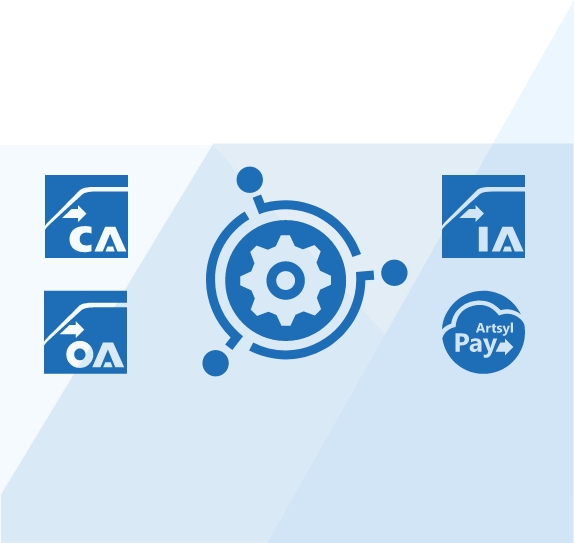Artificial Intelligence has taken over the world’s technology landscape in a big way and businesses of diverse sizes and industries are taking advantage of it to improve their processes and drive innovation. One particular use case of AI that has gained significant popularity in recent years is invoice data extraction.
Invoice data extraction is a tedious and time-consuming task for businesses, especially those that process a large volume of invoices, and AI makes it easier as it automates the process while improving accuracy. In this article, we will take a look at the AI algorithms that drive invoice data extraction and how they work.

Tired of manual data entry errors slowing down your invoice processing?
Upgrade to Artsyl InvoiceAction’s AI-powered invoice data extraction and transform your accounts payable department. Seamlessly extract and validate data from a variety of invoice formats. Click here to see how you can make invoice processing errors a thing of the past.
Why Invoice Data Extraction Is So Challenging
Invoice data extraction is a complex task for several reasons, ranging from the sheer variety of invoice formats to the nuances of the information they contain. Below are some factors that contribute to this challenge.
Variability in Invoice Layout and Design
One of the most prominent challenges is the diversity of invoice formats. Businesses receive invoices from various vendors, each with its own layout, fonts, and designs. This makes it difficult to create a one-size-fits-all solution for data extraction.
Semantic Invoice Complexity
Invoices often contain specialized terminology or codes that are specific to a particular industry or company. Understanding these semantics is crucial for accurate data extraction, but it adds a layer of complexity to the process.
Inconsistent Data Fields
Some invoices may lack specific fields that others possess. For example, one invoice may have a detailed breakdown of services provided, while another may have just a summary. This inconsistency complicates the automation of data extraction.
Invoice Automation Software
Related Videos
Multilingual and Regional Differences in Invoices
Invoices can come in various languages and may follow different cultural or regional formatting norms. Such differences require additional layers of data validation and transformation.
Variable Invoice Image Quality
Many businesses still rely on scanned invoices, which may be of poor quality, further complicating text recognition and data extraction.
Unstructured and Semi-Structured Invoice Data
Invoices often contain both unstructured (free text descriptions, notes, etc.) and semi-structured data (tables, lists). Extracting meaningful information from such diverse formats demands sophisticated algorithms and methods.
Manual Errors in Invoices
The prevalence of manual entry in traditional invoice processing can lead to errors in the data, affecting the quality of the data extracted.
Regulatory and Compliance Invoice Requirements
Especially for industries like healthcare or finance, invoice data extraction must comply with regulations such as GDPR, HIPAA, or Sarbanes-Oxley. Ensuring compliance adds another layer of complexity to the task.
According to a study by Levvel Research, more than 60% of businesses still rely on manual methods for invoice receipt and data entry, signifying both the challenge and opportunity in automating this process («2019 Payables Insight Report»).
Automating invoice data extraction not only necessitates advanced technologies like OCR (Optical Character Recognition), NLP (Natural Language Processing), and machine learning algorithms, but also a deep understanding of the specific use-cases and challenges of the business in question.
Don’t let outdated methods jeopardize your invoice accuracy. Artsyl docAlpha’s state-of-the-art AI technology offers accuracy rates that consistently exceed 95%. Ready to step into the future of financial document management? Discover how our AI and intelligent automation can revolutionize your invoice and order processing today.
Book a demo now
Using AI for Invoice Data Extraction
The age-old process of extracting invoice data can be an arduous task for businesses, especially those dealing with high volumes of invoices. The traditional approach of manually entering data into spreadsheets not only consumes a lot of time but can also be error-prone. Enter AI-powered invoice data extraction, a game-changing technology that can streamline the process and boost productivity.
By leveraging machine learning algorithms, businesses can automate extraction of key data fields from invoices, including vendor names, invoice numbers, date, and amounts. This not only frees up valuable time and human capital but also reduces the risk of manual errors while improving the accuracy of data extraction.
With AI-powered invoice data extraction, businesses can take a giant leap towards digital transformation, creating new opportunities for growth and efficiency. Here are the most common AI algorithms that power invoice data extraction.
Optical Character Recognition (OCR)
OCR is one of the most common AI algorithms for invoice data extraction. OCR is a technology that scans text and handwriting, converts it into machine-encoded text using pattern recognition algorithms, and stores the data in a machine-readable format.
AI-powered OCR uses a combination of computer vision, natural language processing, and machine learning algorithms to identify and extract data from invoices. OCR can also improve invoice data accuracy as it can detect errors and correct them automatically.
Natural Language Processing (NLP)
Invoice data is often presented in unstructured format, making it difficult for traditional data extraction methods. NLP is an AI algorithm that helps machines understand natural human language, making it an ideal tool for the task.
NLP algorithms analyze and categorize the invoice data into specific fields such as company name, address, invoice number, and amount. It can also identify errors in the data and correct them.
Machine Learning (ML)
ML is an AI algorithm that enables machines to learn and improve from experience without being explicitly programmed. In the context of invoice data extraction, ML algorithms rely on training data sets to learn and recognize patterns in the data. The algorithms can then extract the required data fields from invoices with high accuracy levels. ML can also learn to correct and improve the system to make it more accurate over time.
Pattern Recognition
Pattern recognition is an AI algorithm that identifies patterns in data by comparing it with a pre-established set of patterns. In the case of invoice data extraction, pattern recognition can identify similar invoice types, such as purchase orders or credit memos, and extract data from them. It can also identify repetitive data patterns, such as addresses or invoice numbers, and extract them consistently.
Deep Learning
Deep Learning is a subset of machine learning that mimics the human brain’s neural networks. It enables machines to recognize patterns in vast amounts of data with high accuracy levels. Deep learning algorithms are used in invoice data extraction, especially when dealing with complex and unstructured invoice formats. As machines learn, they can understand the data and extract it with minimal manual input.
If you’re not leveraging your invoice data, you’re missing out on key business insights. With Artsyl InvoiceAction, our AI capabilities don’t just extract data, they turn it into actionable intelligence for better decision-making. Want to be data-driven? Click to find out how Artsyl InvoiceAction can
empower your business analytics.
Book a demo now
How Accurate is AI Invoice Data Extraction?
The accuracy of AI-based invoice data extraction can vary based on multiple factors, including the sophistication of the AI model, the quality of the invoices processed, and how well the system has been trained. However, it’s worth noting that advanced AI systems can achieve very high levels of accuracy—often exceeding 95-98%.
According to Deloitte, AI and cognitive technologies are increasingly being used to automate complex processes in domains like finance. Their report states that «automation of document processing and analysis—often performed through machine learning algorithms trained on millions of existing documents—is becoming increasingly feasible.»
AI, robotics, and automation: Put humans in the loop, Deloitte Insights, 2018.
Factors Affecting Accuracy
- Quality of Scanned Invoices: Blurry or low-quality scans can hinder even the most advanced AI models. Good quality input is crucial for high accuracy rates.
- Training Data: A well-trained model that has seen a wide variety of invoices from different industries, formats, and layouts will generally be more accurate.
- Ongoing Learning: Some AI models improve over time, learning from any corrections made to their output. This continuous improvement can lead to near-perfect accuracy rates over time.
- Built-in Validation Rules: Advanced AI systems often have built-in validation rules that cross-reference extracted data with other sources or predetermined criteria, increasing overall accuracy.
- Human-AI Collaboration: Many systems include a verification step where humans can validate the data, offering an additional layer of accuracy.
- Natural Language Processing (NLP): Some of the latest AI models use NLP to understand context, which can be extremely beneficial for ambiguous entries that could otherwise be misinterpreted.
High accuracy rates are crucial because invoice errors can lead to a range of problems, from payment delays and strained vendor relationships to legal complications. Even a 1% error rate can be significant when processing a large volume of invoices.
In summary, while no system can guarantee 100% accuracy, a well-designed, well-trained AI-based invoice data extraction system can come close, providing a highly efficient and reliable method for automating what is traditionally a very labor-intensive process.
Are delayed vendor payments affecting your business relationships? Artsyl docAlpha and its AI-driven financial data extraction fast-tracks the approval process by automating data entry and validation. Take the first step toward building stronger vendor relationships. Learn more about how our AI capabilities can streamline your payment cycle.
Book a demo now
Practical Applications of AI Invoice Data Extraction
Artificial Intelligence (AI) has significantly transformed the way businesses handle invoice data extraction. By leveraging advanced technologies like Optical Character Recognition (OCR), Natural Language Processing (NLP), and machine learning algorithms, AI-based solutions offer various practical applications that improve efficiency, accuracy, and speed in invoice processing. Here are some key practical applications that can be leveraged across industries.
Automated Data Capture
AI can automatically identify and capture crucial data points such as vendor details, invoice numbers, and payment terms. This drastically reduces the time and effort spent on manual data entry, enhancing efficiency.
Intelligent Data Classification
Beyond merely capturing data, AI algorithms can classify and categorize the information based on predefined rules or learned patterns. For instance, they can automatically sort invoices according to payment priorities or vendor categories.
Error Detection and Validation
AI-driven systems can identify discrepancies, duplicate entries, or errors in the invoice data and flag them for review. Some advanced systems may even suggest corrective actions, minimizing the risk of financial errors.
Multilingual and Multi-format Support
With NLP and machine learning capabilities, Artificial Intelligence can process invoices in multiple languages and formats, making it ideal for businesses that deal with international vendors.
Real-Time Data Integration
AI solutions can seamlessly integrate extracted data into existing accounting software or Enterprise Resource Planning (ERP) systems in real-time, ensuring that all systems are up-to-date.
Fraud Detection
By analyzing historical data and recognizing patterns, AI algorithms can identify unusual or suspicious activities, such as invoice fraud, and flag them for investigation.
Scalability
AI systems can easily adapt to higher volumes of invoice data as a business grows, providing a scalable solution that can adjust to changing needs.
Compliance and Governance
Advanced AI systems can also ensure that extracted data complies with regulatory standards like GDPR, HIPAA, or Sarbanes-Oxley, thereby assisting in compliance management.
Predictive Analytics
Once data is extracted and analyzed, AI can offer predictive insights, such as forecasting cash flow based on upcoming invoices and payments, thereby aiding in better financial planning.
Vendor Relationship Management
By automating repetitive tasks and error checks, companies can focus on more strategic activities like building stronger relationships with vendors, as the invoice processing becomes more streamlined and accurate.
According to Gartner, AI adoption in financial management applications is expected to increase by 30% by the end of 2023. This reflects the growing recognition of the transformative impact that AI can have on invoice data extraction and the broader accounts payable process.
In conclusion, the practical applications of AI in invoice data extraction are manifold and offer substantial benefits in terms of operational efficiency, accuracy, compliance, and strategic planning.
Whether you’re a small business or a global enterprise, Artsyl InvoiceAction is designed to scale with you. Our AI technology adapts to various invoice types and layouts, saving you from costly customization. Go ahead and find out how you can scale your invoice processing with complete ease.
Book a demo now
What Types of Invoices Can Artificial Intelligence Handle?
AI-powered invoice data extraction technologies are designed to be incredibly versatile and can handle a diverse range of invoice types. Below are some of the invoice types that advanced AI systems are capable of processing:
- Standard Invoices: These are the most straightforward and common types of invoices that list the services or goods provided and the amount due.
- Commercial Invoices: Typically used in international trade, these invoices contain additional details such as shipping terms, taxes, and tariffs.
- Recurring Invoices: These are regularly issued invoices, often monthly or yearly, for ongoing services such as subscriptions or maintenance contracts.
- Pro forma Invoices: These are preliminary invoices sent before the delivery of goods or services. They are often used for customs declarations when importing or exporting goods.
- Credit Memos: These are issued when a refund is due to the customer, either for returned goods or due to an error in the invoice.
- Utility Bills: Invoices for utilities like electricity, water, or gas can also be processed by AI systems, especially useful for businesses with multiple locations.
- Purchase Orders: While not technically an invoice, some advanced AI systems can extract and integrate information from purchase orders for validation and cross-reference purposes.
- Electronic Invoices: These invoices are sent via email or through a secure portal. AI systems can often process these automatically from an inbox.
- PDF Invoices: AI systems are generally adept at extracting information from PDF files, even if the text is embedded in an image.
- Multi-Page Invoices: Complex invoices that span multiple pages can be processed accurately by advanced AI systems, which can stitch together related pages for comprehensive data extraction.
- Multi-Language Invoices: Global businesses often deal with invoices in multiple languages. Advanced AI systems can handle invoices in different languages and even perform real-time translation.
- Industry-Specific Invoices: Whether it’s healthcare, construction, or legal services, AI systems can be trained to recognize and extract industry-specific terminologies and data fields.
According to a report by McKinsey, automation technologies like AI have the potential to transform various business functions, including finance. Specifically, AI can automate 42% of finance activities, thus, making it incredibly beneficial for managing different types of invoices.
The ability to handle diverse types of invoices makes artificial intelligence an invaluable asset for businesses looking to automate their invoice processing and accounts payable workflows, regardless of their industry, scale, or geographical location.
In an era where data security is paramount, can you afford to stick with manual processes? Artsyl docAlpha employs cutting-edge AI algorithms that adhere to stringent security protocols, ensuring your financial data is safeguarded at all times. Take action to secure your financial future by opting for Artsyl AI-driven intelligent automation solutions today.
Book a demo now
Final Thoughts: Simplifying Invoice Data Extraction with AI
In conclusion, invoice data extraction is a time-consuming task for businesses, and AI algorithms can help to automate the process and improve accuracy. By using OCR, NLP, ML, Pattern Recognition, or Deep Learning, businesses can extract invoice data consistently, accurately, and efficiently.
While each AI algorithm is effective, companies must identify which algorithm works best for their data extraction task and tailor it to their specific needs. As AI continues to evolve, the potential for AI algorithms to drive innovation and streamline business processes is limitless.
Frequently Asked Questions About AI Invoice Data Extraction
What is AI Invoice Data Extraction?
AI Invoice Data Extraction involves the use of Artificial Intelligence technologies, including machine learning and natural language processing, to automatically identify, capture, and sort relevant data from invoices. These technologies significantly reduce the need for manual entry and improve accuracy.
How Does AI Improve the Invoice Data Extraction Process?
AI enhances the invoice extraction process by automating data capture, improving accuracy, identifying errors, and integrating seamlessly with accounting software or Enterprise Resource Planning (ERP) systems. These capabilities make the process faster and more efficient.
Is AI Invoice Data Extraction Secure?
Yes, most AI-based invoice data extraction solutions incorporate robust security measures, such as data encryption and multi-factor authentication, to ensure the security of sensitive financial information.
What Varieties of Invoices Are Compatible with AI?
AI can process a wide range of invoices, including paper-based, PDFs, and electronic invoices. Advanced systems can handle multiple formats and languages, making it ideal for companies that have international vendors.
Can AI Handle Complex Invoices with Multiple Line Items?
Yes, advanced AI systems can capture complex invoice data, including multiple line items, and classify them appropriately. They can also validate the captured data against purchase orders to ensure accuracy.
How Can AI Help in Error Detection?
AI algorithms are adept at identifying discrepancies, duplicate entries, and other errors in the invoice data. They can flag these for human review or even suggest corrective actions.
Is It Difficult to Integrate AI Invoice Data Extraction into Existing Systems?
Most modern AI invoice data extraction solutions are designed to integrate easily with existing accounting or ERP software, often requiring minimal changes to current workflows.
Does Artificial Intelligence Assist in Compliance and Governance?
Yes, some AI-based systems are equipped to ensure compliance with various regulatory standards like GDPR, HIPAA, or Sarbanes-Oxley, assisting in compliance management.
Can Small Businesses Benefit from AI Invoice Data Extraction?
Absolutely, AI-based solutions come in scalable models that can benefit both small businesses and large enterprises. By reducing manual effort and improving accuracy, even small operations can see a quick return on investment.
What is the Future of AI in Invoice Data Extraction?
According to Gartner’s prediction, AI adoption in financial management applications will increase significantly in the coming years. As AI technologies continue to evolve, we can expect even more advanced capabilities, including real-time analytics and predictive modeling.



 The Ultimate Guide to Final Invoices
The Ultimate Guide to Final Invoices Credit Invoice or Credit Note? Find Out The Difference
Credit Invoice or Credit Note? Find Out The Difference Recurring Invoice: What is It?
Recurring Invoice: What is It? Debit Invoice and Debit Note: What Is It
Debit Invoice and Debit Note: What Is It Timesheet Invoice: What Is It?
Timesheet Invoice: What Is It? Exploring Various Invoice Types: Unveiling the Differences
Exploring Various Invoice Types: Unveiling the Differences
